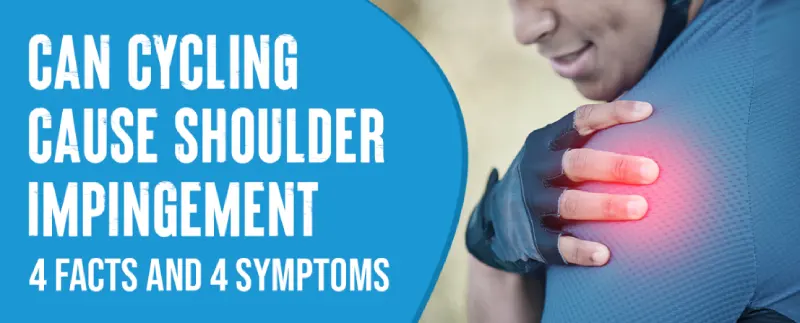Shoulder impingement occurs when a tendon rubs or catches on nearby tissues and bones. A rotator cuff injury affects the tendon, which attaches your shoulder joint to your arm.
Yes, shoulder impingement can occur from cycling. The endurance aspect of cycling often makes rides last over an hour. This puts a considerable strain on the shoulders. Most importantly, this is true for the rotator cuff, a crucial shoulder stabilizer.
In this blog post, we’ll discuss what shoulder impingement is, how it can be caused or exacerbated by cycling, and provide tips and advice on how to avoid it.
Can Cycling Cause Shoulder Impingement? 4 Risks & Fixes

Cycling can cause shoulder impingement pain if cyclists do not adequately care for their shoulder health and biomechanics. An impingement in the shoulder occurs when the muscles surrounding the shoulder blade or the fluid-filled sac cushioning the joint irritate or inflame the rotator cuff tendons.
This can cause pain, stiffness, and reduced range of motion in the shoulder. Some common causes and risk factors of shoulder impingement for cyclists are:
Overuse
Repeated or prolonged activities involving raising the arm above the head or behind the back, such as cycling, can stress the rotator cuff tendons and cause them to rub against the acromion or the bursa. This can lead to inflammation, swelling, and micro-tears in the tendons.
Injury
A sudden or forceful shoulder movement, such as a fall, a collision, or a direct blow while cycling, can damage the rotator cuff tendons or the surrounding structures. This can result in acute shoulder pain, swelling, and bruising.
Inflammation
Certain medical conditions, such as arthritis, bursitis, tendinitis, or cycling, can cause inflammation in the shoulder joint or the surrounding tissues. This can reduce the space available for the rotator cuff tendons and increase the friction between them and the acromion or the bursa.
Degeneration
As we age, tendons in the rotator cuff and surrounding structures can wear and tear, leading to degenerative changes, such as thinning, fraying, or tearing of the tendons or bone spurs on the acromion. This can also reduce rotator cuff space and increase friction between the tendons and the acromion. Cycling can also exacerbate these issues.
Cycling & Shoulder Impingement: Symptoms
Extended periods of riding a bike can lead to shoulder pain. Early recognition of the signs is essential for appropriate medical attention. Some specific symptoms of shoulder impingement that cyclists should be aware of include:
- Pain or discomfort in the shoulder joint when raising the arm overhead or reaching behind the back.
- A dull ache in the upper arm or shoulder area may worsen during and after cycling.
- Reduced range of motion and stiffness, causing difficulty performing daily activities.
- The affected arm is weak or has lost strength.
Cycling Shoulder Impingement: Diagnosis

If you suspect shoulder impingement, your doctor may examine you and perform several tests to diagnose and treat the condition. These include:
- Physical examination: The doctor will check your shoulder, looking for signs of pain and limited movement
- Imaging tests: X-rays, MRIs, and ultrasounds can provide accurate images of the shoulder joint to identify any damage or inflammation
- Electromyography (EMG): This test measures nerve activity in the muscles of the shoulder to determine if there is any nerve damage or dysfunction present
- Injection: A local anesthetic or corticosteroid injection may be given to alleviate pain and inflammation and to help diagnose the severity of the condition
Shoulder Impingement in Cyclists: Examples and Insights from Experts
Shoulder impingement is a complex condition, and treatment varies with age, activity level, and injury severity. Physiotherapists and other experts recommend a range of treatments, including rest, physical therapy, medication, and, in severe cases, surgery. Some specific examples of treatments that may be recommended for cyclists experiencing shoulder impingement include:
- Rest and avoid exacerbated activities.
- Flexible and range-of-motion strengthening exercises.
- Reducing inflammation and pain with heat or ice.
- Massage and manual therapy to release tight muscles and improve circulation of cyclist sore shoulder.
- Surgery to remove any bone spurs or inflamed tissue that may be causing impingement.
Conclusion
Cycling is an incredible way to stay active and healthy, but like any physical activity, it comes with risks. Shoulder impingement can be debilitating, making it challenging to continue cycling and other daily activities.
Taking steps to avoid risk factors and working with a doctor or physical therapist makes it possible to enjoy cycling while maintaining healthy shoulders. Remember to prioritize your shoulder health so you can continue doing what you love for years.
FAQs
How Does Shoulder Impingement Flare Up?
Tendon inflammation, thickening, or tearing can occur due to injury, excessive shoulder use (e.g., swimming or tennis), or the natural effects of aging.


